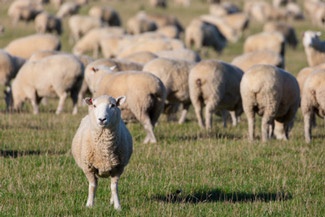Can sheep recognize Barack Obama?
 In addition to humans, we often discuss the cognitive capacities of ravens and chimpanzees in our newsletters. Well for this newsletter, we thought it was high time to take a look at sheep! A research team at Cambridge University (England) recently tested sheep’s ability to recognize famous human faces using photographs. Were the sheep able to identify Emma Watson and Barack Obama?
In addition to humans, we often discuss the cognitive capacities of ravens and chimpanzees in our newsletters. Well for this newsletter, we thought it was high time to take a look at sheep! A research team at Cambridge University (England) recently tested sheep’s ability to recognize famous human faces using photographs. Were the sheep able to identify Emma Watson and Barack Obama?Several studies have shown that, just like rhesus macaques, horses, dogs, and mocking birds, sheep have the ability to recognize both other sheep as well as familiar human faces. Yet we knew very little about their overall ability to recognize faces. To learn more, researchers from the Departments of Physiology, Development, and Neuroscience at Cambridge decided to see if sheep could effectively be trained to recognize famous faces. To do so, the team selected 8 sheep (Welsh Mountain females, ages 7-8 years; 45-70kg) that were already familiar with cognitive tests (no habituation phase was needed).
The training was carried out as follows: each animal was taken individually from a waiting pen and placed in a pre-test area where the sheep could move at its own pace, eventually entering into the test area (by passing in front of an infrared sensor located in a corridor). Two computer screens were installed in the test area and an empty trough was placed below each screen. Visual stimuli were then presented to the sheep. Depending on the sheep’s “choice” (validated when the animal passed in front of the infrared ray near the screen), the sheep would or would not receive a reward (food). After 4 days of performing 12 trials per day, the animals learned to distinguish the photographs of 4 famous people (Emma Watson, Barack Obama, Fiona Bruce and Jake Gyllenhaal) versus a black screen (session 1), a photo of an object (session 2), and an unfamiliar face (session 3). The sheep could only receive the food reward by physically approaching the screen projecting the eternal Hermione from Harry Potter, the former President of the United States, the British journalist, or the American actor. The results of session 3 were remarkable because 80% of the time, the sheep chose the celebrity face over the strange face.
The researchers also wanted to test facial recognition when the faces were presented from different angles. Indeed, during all of the previous trainings, the faces were only shown from the front. In a specific session, the faces of the celebrities were displayed differently; they were slightly tilted to the left or right. While the recognition scores dropped by 15%, the sheep’s performance is surprisingly similar to human performance on the same task.
In a final experiment, the scientists wanted to test the sheep’s ability to recognize a familiar face (a farmer who was in contact with them for about 2 hours each day) without giving the sheep any prior training. When his photo was placed randomly amongst the photos of celebrities, the sheep still recognized it 70% of the time.
J. Morton’s team thus showed that sheep have advanced facial recognition abilities, comparable to those seen in monkeys and humans.
Source: Knolle, F, Rita P. Goncalves, A.J. Morton, “Sheep recognize familiar and unfamiliar human faces from two-dimensional images.” Royal Society Open Science; Nov 2017







